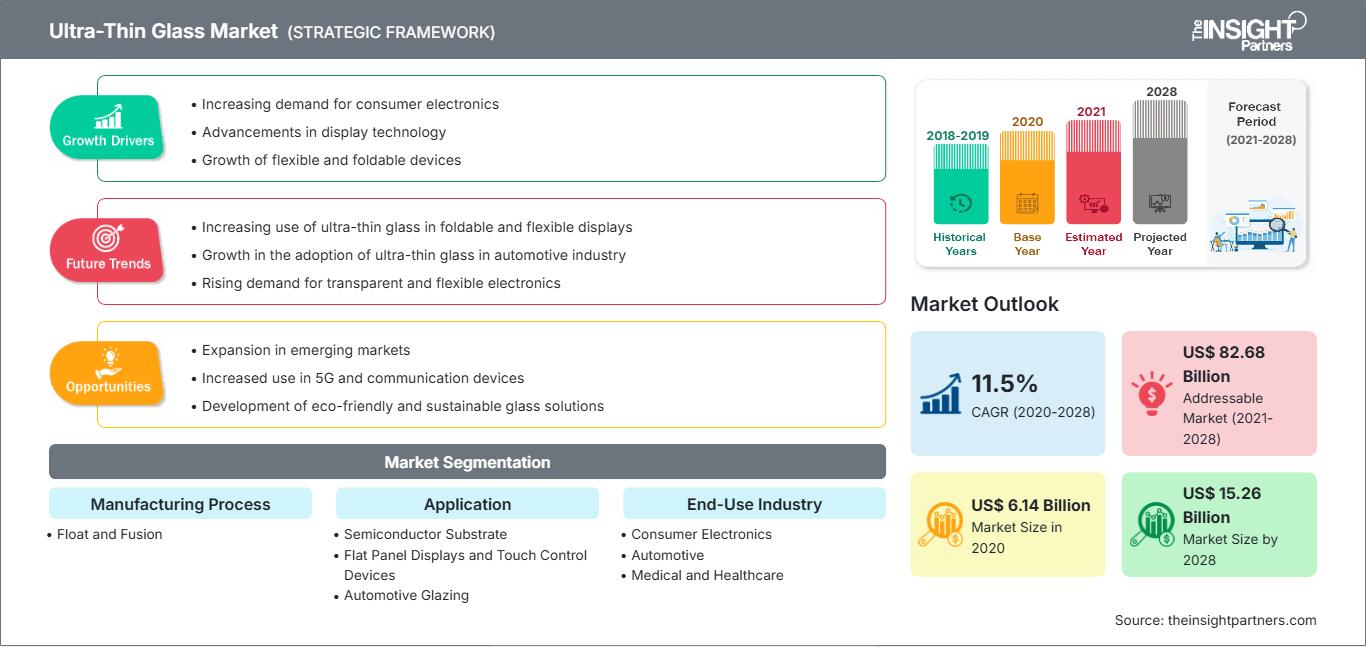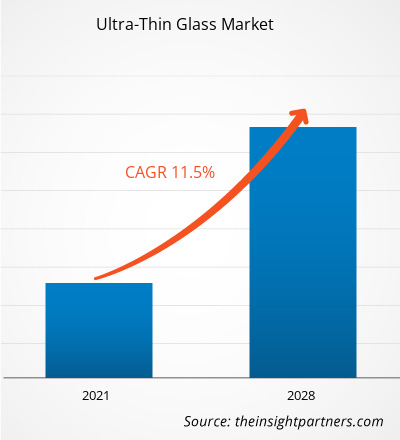[Informe de investigación] El mercado de vidrio ultrafino se valoró en US$ 6.139,56 millones en 2020 y se proyecta que alcance los US$ 15.264,74 millones para 2028; se espera que crezca a una CAGR del 11,5% de 2021 a 2028.
El vidrio ultrafino es aquel cuyo espesor es inferior a 1-2 mm. El reforzamiento químico mediante intercambio iónico se utiliza comúnmente para reforzar el vidrio ultrafino empleado en aplicaciones de alta tecnología. El vidrio ultrafino endurecido es resistente a los arañazos y se puede doblar hasta un radio de unos pocos milímetros. Sus propiedades, como la resistencia a la corrosión, la transparencia, la flexibilidad, la excelente barrera a gases y agua, y la alta resistencia al impacto, lo hacen adecuado para diversas aplicaciones, como pantallas planas y acristalamiento de automóviles, entre otras. En 2020, Asia Pacífico tuvo la mayor participación en los ingresos del mercado mundial de vidrio ultrafino. China es el mayor consumidor de vidrios ultrafinos, con más del 50 % de la cuota de mercado en Asia Pacífico. El país es el principal centro de fabricación de todo tipo de productos electrónicos de consumo, como teléfonos inteligentes y pantallas LCD.
La pandemia de COVID-19 ha alterado drásticamente el estado del sector de productos químicos y materiales, y ha afectado negativamente al crecimiento del mercado del vidrio ultrafino. La implementación de medidas para combatir la propagación del nuevo coronavirus ha agravado la situación y ha afectado negativamente al crecimiento de varios sectores. Industrias como la automotriz y la electrónica de consumo se han visto afectadas negativamente por la repentina distorsión en las eficiencias operativas y las interrupciones en las cadenas de valor debido al cierre repentino de las fronteras nacionales e internacionales. La disminución del crecimiento de varios sectores afectó negativamente la demanda de vidrio ultrafino en el mercado global. Sin embargo, a medida que las economías planean reactivar sus operaciones, se espera que la demanda de vidrio ultrafino aumente a nivel mundial en los próximos años. Debido a la pandemia, la adopción de la cultura del trabajo remoto y la educación en línea está creciendo. Por lo tanto, la demanda de productos como computadoras portátiles, teléfonos inteligentes y otros dispositivos de telecomunicaciones está creciendo. Se espera que la creciente demanda de vidrio ultrafino en diversas industrias, como la automotriz y la electrónica de consumo, junto con importantes inversiones de fabricantes destacados, impulsen el crecimiento del mercado de vidrio ultrafino durante el período de pronóstico.
Personalice este informe según sus necesidades
Obtendrá personalización en cualquier informe, sin cargo, incluidas partes de este informe o análisis a nivel de país, paquete de datos de Excel, así como también grandes ofertas y descuentos para empresas emergentes y universidades.
Mercado de vidrio ultrafino: Perspectivas estratégicas

-
Obtenga las principales tendencias clave del mercado de este informe.Esta muestra GRATUITA incluirá análisis de datos, desde tendencias del mercado hasta estimaciones y pronósticos.
Perspectivas del mercado
Creciente industria de la electrónica de consumo
La industria de la electrónica de consumo está en auge debido al creciente uso de electrodomésticos, como teléfonos inteligentes, computadoras portátiles, televisores y otros productos electrónicos. Los productos electrónicos de consumo se han convertido en una necesidad en el mundo tecnológico. Personas de todas las generaciones dependen de sus teléfonos inteligentes, relojes inteligentes y computadoras portátiles. Con el crecimiento de la industria de la electrónica de consumo, los fabricantes se centran continuamente en ofrecer productos avanzados y de alta calidad. El vidrio ultrafino desempeña un papel importante en la industria de la electrónica de consumo. Se utiliza en paneles táctiles y de visualización, sensores y sistemas de cámara. Diversas propiedades del vidrio ultrafino, como la resistencia a la corrosión, la transparencia, la flexibilidad y la capacidad de barrera a los gases, lo hacen adecuado para numerosas aplicaciones en la industria de la electrónica de consumo. China domina la industria de los productos electrónicos de consumo. El país es uno de los principales fabricantes de pantallas planas. La demanda de teléfonos inteligentes, pulseras de actividad física, televisores y otros productos electrónicos chinos está en rápido crecimiento, lo que ofrece oportunidades lucrativas a los fabricantes de vidrio ultrafino. China ha fortalecido la construcción de nuevas infraestructuras; ha promovido el desarrollo de la inteligencia artificial, el internet industrial y el internet de las cosas; y aceleró el ritmo de comercialización del 5G, lo que impulsa la industria de fabricación de información electrónica a una nueva etapa de desarrollo y promueve aún más el desarrollo de alta gama de industrias relacionadas. Según World Population Review, China tiene 1.600 millones de usuarios de teléfonos celulares e India, 1.280 millones. En 2018, Apple registró alrededor de 22,5 millones de envíos de relojes inteligentes. Esta cifra ha aumentado con respecto a 2017, ya que la compañía vendió 17,7 millones de unidades en 2017. En 2018, Fitbit envió alrededor de 5,5 millones de unidades de relojes inteligentes, mientras que Samsung envió alrededor de 5,3 millones. Por lo tanto, el rápido crecimiento de la industria de la electrónica de consumo impulsa la demanda de gafas ultrafinas.
Perspectivas de la industria de uso final
El segmento de electrónica de consumo representó la mayor participación en el mercado mundial de vidrio ultrafino en 2020. Este tipo de vidrio se utiliza ampliamente en la fabricación de productos electrónicos, como pantallas planas y táctiles para diversos dispositivos, como LCD, OLED, teléfonos inteligentes y wearables. Ante la creciente demanda mundial de productos electrónicos innovadores y tecnológicamente avanzados, se prevé un aumento de la demanda de vidrio ultrafino en los próximos años.
Perspectivas del proceso de fabricación
Por proceso de fabricación, el segmento de fusión dominó el mercado del vidrio ultrafino en términos de ingresos en 2020. Este proceso, conocido como método de extracción por desbordamiento, se utiliza ampliamente para fabricar vidrios planos ultrafinos para paneles de visualización. Corning fue la primera empresa en crear vidrio especializado suspendido en el aire, una característica clave del método de fusión. El vidrio no entra en contacto con el metal fundido, lo cual constituye una ventaja fundamental del método de fusión sobre el vidrio flotado.
Algunos de los actores clave del mercado que operan en el mercado de vidrio ultrafino son Corning Incorporated; AGC Inc.; Nippon Electric Glass Co., Ltd.; SCHOTT AG; Central Glass Co., Ltd.; CSG Holding Co., Ltd.; Emerge Glass; Nippon Sheet Glass Co., Ltd; Xinyi Glass Holdings Limited; y Luoyang Glass Co., Ltd. Los principales actores del mercado están adoptando estrategias como fusiones y adquisiciones y lanzamientos de productos para expandir su presencia geográfica y su base de consumidores.
Perspectivas regionales del mercado del vidrio ultrafino
Los analistas de The Insight Partners han explicado detalladamente las tendencias regionales y los factores que influyen en el mercado del vidrio ultrafino durante el período de pronóstico. Esta sección también analiza los segmentos y la geografía del mercado del vidrio ultrafino en Norteamérica, Europa, Asia Pacífico, Oriente Medio y África, y Sudamérica y Centroamérica.
Alcance del informe de mercado de vidrio ultrafino
| Atributo del informe | Detalles |
|---|---|
| Tamaño del mercado en 2020 | 6.140 millones de dólares estadounidenses |
| Tamaño del mercado en 2028 | US$ 15.26 mil millones |
| CAGR global (2020-2028) | 11,5% |
| Datos históricos | 2018-2019 |
| Período de pronóstico | 2021-2028 |
| Segmentos cubiertos |
Por proceso de fabricación
|
| Regiones y países cubiertos |
América del norte
|
| Líderes del mercado y perfiles de empresas clave |
|
Densidad de actores del mercado de vidrio ultrafino: comprensión de su impacto en la dinámica empresarial
El mercado del vidrio ultrafino está creciendo rápidamente, impulsado por la creciente demanda del usuario final debido a factores como la evolución de las preferencias del consumidor, los avances tecnológicos y un mayor conocimiento de los beneficios del producto. A medida que aumenta la demanda, las empresas amplían su oferta, innovan para satisfacer las necesidades del consumidor y aprovechan las tendencias emergentes, lo que impulsa aún más el crecimiento del mercado.

- Obtenga una descripción general de los principales actores clave del mercado de vidrio ultrafino
Informe destacado
- Tendencias progresivas en la industria del vidrio ultrafino para ayudar a los actores a desarrollar estrategias efectivas a largo plazo
- Estrategias de crecimiento empresarial adoptadas por las empresas para asegurar el crecimiento en los mercados desarrollados y en desarrollo
- Análisis cuantitativo del mercado global de vidrio ultrafino de 2019 a 2028
- Estimación de la demanda de vidrio ultrafino en diversas industrias
- Análisis de Porter para ilustrar la eficacia de los compradores y proveedores que operan en la industria para predecir el crecimiento del mercado
- Desarrollos recientes para comprender el escenario competitivo del mercado y la demanda de vidrio ultrafino
- Tendencias y perspectivas del mercado junto con los factores que impulsan y restringen el crecimiento del mercado de vidrio ultrafino
- Comprensión de las estrategias que sustentan el interés comercial con respecto al crecimiento del mercado mundial de vidrio ultrafino, ayudando en el proceso de toma de decisiones.
- Tamaño del mercado de vidrio ultrafino en varios nodos del mercado
- Descripción general detallada y segmentación del mercado mundial de vidrio ultrafino, así como su dinámica industrial.
- Tamaño del mercado de vidrio ultrafino en varias regiones con prometedoras oportunidades de crecimiento
Mercado de vidrio ultrafino, por proceso de fabricación
- Flotar
- Fusión
Mercado de vidrio ultrafino, por aplicación
- Sustrato semiconductor
- Pantallas planas y dispositivos de control táctil
- Acristalamiento automotriz
- Otros
Mercado de vidrio ultrafino, por industria de uso final
- Electrónica de consumo
- Automotor
- Medicina y atención sanitaria
- Otros
Perfiles de empresas
- Corning Incorporated
- AGC Inc.
- Compañía de vidrio eléctrico Nippon, Ltd.
- SCHOTT AG
- Compañía Central de Vidrio, Ltd.
- Compañía holding CSG, Ltd.
- Emerge Glass
- Nippon Sheet Glass Co., Ltd
- Xinyi Glass Holdings Limited
- Compañía de vidrio Luoyang, Ltd.
- Análisis histórico (2 años), año base, pronóstico (7 años) con CAGR
- Análisis PEST y FODA
- Tamaño del mercado, valor/volumen: global, regional y nacional
- Industria y panorama competitivo
- Conjunto de datos de Excel
Informes recientes
Informes relacionados
Testimonios
Razón para comprar
- Toma de decisiones informada
- Comprensión de la dinámica del mercado
- Análisis competitivo
- Información sobre clientes
- Pronósticos del mercado
- Mitigación de riesgos
- Planificación estratégica
- Justificación de la inversión
- Identificación de mercados emergentes
- Mejora de las estrategias de marketing
- Impulso de la eficiencia operativa
- Alineación con las tendencias regulatorias






















 Obtenga una muestra gratuita para - Mercado de vidrio ultrafino
Obtenga una muestra gratuita para - Mercado de vidrio ultrafino